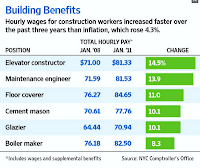By ANTHONY KLAN
A much-heralded cost reduction program launched two years ago by New York unions and contractors to stimulate construction has come to a halt ahead of a major round of contract negotiations.
 |
| Click to enlarge. |
"Quite frankly we don't know what conditions are going to be agreed to [in the contract talks] so it made no sense to extend that particular agreement," said Gary La Barbera, president of the Building & Construction Trades Council of Greater New York, an umbrella union group.
The move by union officials marks the latest maneuver as unions and contractors prepare to renegotiate 30 collective bargaining agreements to be redrawn by June 30. These talks are traditionally tough but this year they're shaping up to be particularly acrimonious, as both sides struggle with the continuing impact of the economic downturn.
Louis Coletti, president of the Building Trades Employers' Association representing contractors said it was a "mistake" to not renew the program in the current economic climate. He said the move sent a "terrible signal" to contractors who he said were trying to work with unions, rather than employing non-union workers.
The 2009 cost-reduction program, called the Economic Recovery Project Labor Agreement, represented an unprecedented effort by management and labor to control New York's high construction labor expenses. The deal was their response to the economic downturn, which prompted scores of developers to mothball projects.
But the program has been controversial because the program's actual savings haven't been as great as participants predicted.
Steven Spinola, president of the Real Estate Board of New York, says the actual savings is a "very contentious issue" and "no one knows for sure" the amount. But he estimated it to be between 2% and 5%, far short of the 15% to 20% savings that had been forecast.
The program set up a system for contractors and unions to change work rules and even cut hourly wages using "project labor agreements." Developers have been able to negotiate such agreements on a project-by-project basis for years. But the 2009 deal provided a template that theoretically made it easier to apply it to most jobs.
As it turned out, though, the majority of savings under the program came from work-rule changes, aimed at improving worker productivity, rather than changes to wages and benefit rates, according to the contractors' association.
A Wall Street Journal analysis of data collected by the City of New York Comptroller shows official prevailing wage rates for construction workers during the downturn have climbed by an average of about 12% for the three years starting in January 2008, almost three times the 4.3% increase in inflation for the same period.
For example, a New York bricklayer now receives $45.98 an hour in wages and $25.71 an hour in supplemental benefits, up from $40.34 and $22.71, respectively, three years earlier, the comptroller's office said.
Mr. Spinola says the increase in wage rates outpaced inflation partly because many collective agreements covered three- to four-year terms beginning 2007 and 2008 when the market was far more buoyant.
Mr. La Barbera said he believed the 12% figure to be overstated for non-government jobs because the comptroller's office may have not been made aware of the labor cost reductions brokered under project labor agreements, and of similar changes agreed to by some trades during collective bargaining talks.
He estimated the average increase in wages and benefits to be about 6% for union workers on non-government sites during that period. However, workers on government projects would have been paid the full increased rates, Mr. La Barbera said.
Mr. La Barbera said his organization was meeting with individual developers and that project labor agreements could be made on a case-by-case basis despite its decision to let the broader Economic Recovery deal to expire.
More collective bargaining contracts in the construction business are up for renewal in 2011 than in an average year. The contractor association has called for major concessions, warning that its members could move to non-union workers.
Contractors want to remain "100% union contractors" but they were losing projects to non-union competitors, Mr. Coletti said.



DROP DEAD UNITY TEAM !
ReplyDelete